Ethylene
Ethylene (C2H4) is a gas that is produced by plants and as a byproduct of incomplete combustion. Ethylene is both a useful plant growth regulator and a harmful contaminant in greenhouses. During production, plants may be exposed to low levels (25 to 200 ppb[parts per billion]) of ethylene for weeks or even months. The source of ethylene is usually an improperly vented or malfunctioning heater, and the result is malformed or stunted growth and flowering delays that may make a crop unmarketable (see previous articles). In these instances, ethylene damage can be very hard to distinguish from nutritional disorders or disease problems. Ethylene damage following production (i.e. postproduction) can be more extreme and symptoms can appear very quickly. During packaging, shipping and retailing, plants are more likely to be exposed to higher concentrations (1 ppm [parts per million] or more) of ethylene for shorter periods of time (from a few hours to a few days).
The keys to preventing postproduction ethylene damage are to reduce ethylene production by the plant, to prevent exposure to external sources of ethylene, and to protect the plant from ethylene (both external and internal). Ethylene management strategies must be part of the proper postproduction care and handling of greenhouse crops, especially during shipping.
Symptoms of ethylene damage
Symptoms of short term exposure to higher concentrations of ethylene include the accelerated senescence of leaves and flowers. This is seen as increased leaf yellowing and flower wilting. Plants may shed or abscise leaves, buds, or flowers. A very characteristic symptom of ethylene damage is epinasty, or the downward growth of the leaf petiole. While at first glance this looks like water stress, plants are fully turgid and this droopy appearance is the result of ethylene.
The severity of ethylene damage depends on how sensitive the plant is to ethylene, how much ethylene they are exposed to, how long they are exposed, and the temperature during exposure. As mentioned above, reducing shipping temperatures can be an effective way to reduce or prevent ethylene damage. Some plant species are known to be highly sensitive to ethylene, while some have very low sensitivity. Plants with high sensitivity to ethylene may show damage upon exposure to lower doses of ethylene (i.e. at lower concentrations and over shorter periods of time). For example, geraniums my lose petals when exposed to only 100 ppb (0.1 ppm) ethylene for a few hours. Some plants have low sensitivity to ethylene, which means they show very minimal symptoms (or none at all) even when exposed to very high concentrations of ethylene (as high as 10 ppm) for days. Marigolds and zinnias are examples of plants with very low ethylene sensitivity. They are often referred to as ethylene insensitive crops. Marigolds may show very slight leaf epinasty (curving of the leaves) after 24 hours of exposure to 10 ppm ethylene, but once they are removed from the ethylene they will completely recover in less than 1 day.
If ethylene accumulates in the truck during shipping, many crops including torenia, geranium, alyssum, impatiens, salvia, and snapdragons may lose most or all of their open blooms. As concentrations of ethylene increase, flower buds will also abscise. When salvia are exposed to ethylene for 24 hours, even 0.01 ppm (10 ppb) ethylene results in the loss of a few petals (Figure 1). Increasing amounts of ethylene cause more flower abscission, with 1 and 10 ppm ethylene resulting in the loss of 50% to 85% of the petals, respectively. Petunias show accelerated flower senescence (Figure 2). A few flowers will wilt when plants are exposed to 0.1 ppm ethylene, but exposure to 1 or 10 ppm ethylene for 24 hours causes all of the open flowers to wilt. Portulaca flowers also show accelerated wilting, but the most striking symptom in these plants is the extreme leaf abscission (Figure 3). Tomato plants have very high sensitivity to ethylene. While more mature plants may abscise buds, flowers and fruits, the most common symptom of ethylene damage is leaf epinasty (Figure 4). In figure 4 this can be seen as the downward curvature of the leaf petioles in the plants exposed to 1 and 10 ppm ethylene.
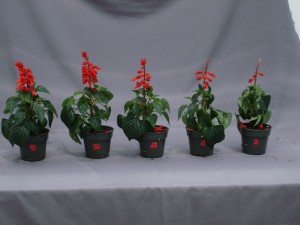
Figure 1. Symptoms of ethylene damage in salvia. Plants were treated with different concentrations of ethylene (0, 0.01, 0.1, 1.0, and 10 ppm from left to right) for 24 hours to observe the symptoms of flower abscission.
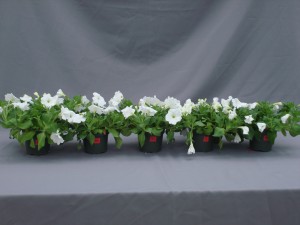
Figure 2. Symptoms of ethylene damage in petunia. Plants were treated with different concentrations of ethylene (0, 0.01, 0.1, 1.0, and 10 ppm from left to right) for 24 hours to observe the symptoms of flower senescence.
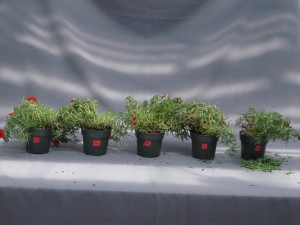
Figure 3. Symptoms of ethylene damage in portulaca. Plants were treated with different concentrations of ethylene (0, 0.01, 0.1, 1.0, and 10 ppm from left to right) for 24 hours to observe the symptoms of flower senescence and leaf abscission.
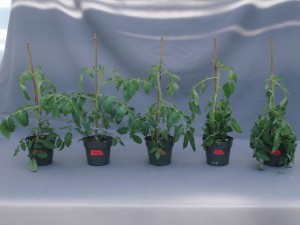
Figure 4. Symptoms of ethylene damage in tomato. Plants were treated with different concentrations of ethylene (0, 0.01, 0.1, 1.0, and 10 ppm from left to right) for 24 hours to observe the symptoms of leaf epinasty.
While most crops will resume flowering within a few weeks, customers expect color, and crops that arrive at retail locations without blooms will be considered unmarketable. Bedding plants like tomato that show even very severe symptoms of leaf epinasty will often recover and have normal leaf growth within days of removal from ethylene (Figure 5). Crops that exhibit leaf epinasty, as their only symptom of ethylene damage, are the most likely to remain marketable.
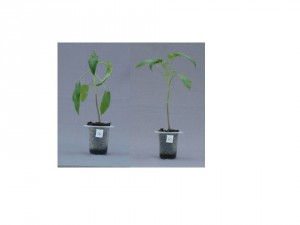
Figure 5. Epinasty in tomato ‘Brandywine Pink’ exposed to 10 ppm ethylene for 24 hours. The plant showed severe leaf epinasty immediately after exposure (left photo) and was completely recovered after 24 hours in air (right photo).
Within a species, ethylene sensitivity can vary by cultivar. Figure 6 shows that petal abscission varied between cultivars of seed geraniums. After 24 hours of exposure to 1 ppm ethylene cv Fox lost 82% of its petals, while cv Kim lost only 41%. If you have problems with ethylene damage during the shipment of a certain crop, it may be possible for you to identify a cultivar with lower sensitivity to ethylene that will have better shipping quality. The proper postproduction care and handling of bedding plants and potted plants must include steps to prevent ethylene damage. Future articles will look at how to avoid exposing plants to ethylene, how to reduce ethylene production from plants, and how to protect plants from ethylene damage.
Michelle Jones, PhD
DC Kiplinger Floriculture Chair
The Ohio State University
Department of Horticulture and Crop Science
330-263-3885
Jones.1968@osu.edu

